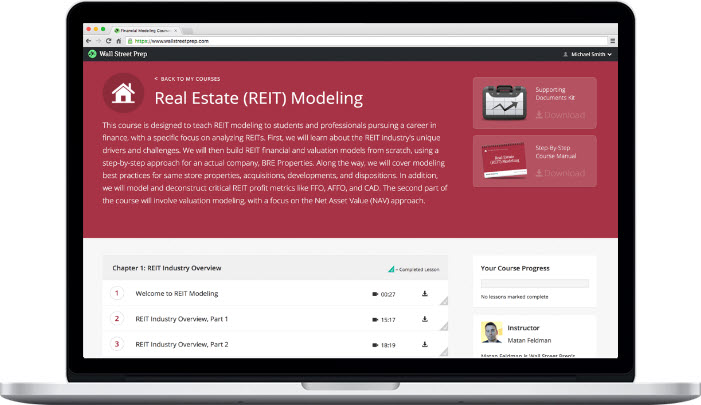Description
Wall Street Prep – Real Estate (REIT) Modeling
This REIT modeling course is ideal for investment banking, equity research, and real estate professionals with a focus on REITs. Trainees build financial and valuation models for a REIT the way it’s done on the job.
First, we will learn about the REIT industry’s unique drivers and challenges. We will then build REIT financial and valuation models from scratch, using a step-by-step approach for an actual company, BRE Properties. Along the way, we will cover real estate modeling best practices for same store properties, acquisitions, developments, and dispositions. In addition, we model and deconstruct critical REIT profit metrics like FFO, AFFO, and CAD. Part 2 dives into valuation modeling, with a focus on the Net Asset Value (NAV) approach.
What You’ll Learn In Real Estate (REIT) Modeling?
- In-depth REIT industry profile, drivers, terminology, tax advantages and structure (UPREIT’s and DOWNREIT’s)
- Segment-level modeling (same store properties, acquisitions, developments, and dispositions)
- REIT sector-specific drivers and forecasting best practices
- Common REIT valuation approaches including Net Asset Value (NAV), comparable company and transaction analyses, and discounted cash flow (DCF) analysis
- Modeling REIT-specific metrics and ratios – funds from operations (FFO) and adjusted funds from operations (AFFO / CAD)
Content:
Chapter 1: REIT Industry Overview
1. Welcome to REIT Modeling
2. REIT Industry Overview, Part 1
3. Course Downloads
4. REIT Industry Overview, Part 2
Chapter 2: Modeling A REIT’s Income Statement
5. Modeling the Income Statement, Part 1
6. Modeling the Income Statement, Part 2
7. Modeling the Income Statement, Part 3
Chapter 3: Understanding & Modeling REIT’s Segments
8. REIT Segments: Same Store Sales, Part 1
9. REIT Segments: Same Store Sales, Part 2
10. REIT Segments: Same Store Expenses and NOI
11. REIT Segments: Lease Ups, Renovations & Acquisitions
12. REIT Segments: Dispositions & Discontinued Ops, Part 1
13. REIT Segments: Dispositions & Discontinued Ops, Part 2
14. Modeling Segments: Same Store Properties
15. Modeling Segments: Acquisitions
16. Modeling Segments: Dispositions
17. Modeling Segments: Discontinued Ops and Dispositions Cleanup
18. Modeling Segments: Development
Chapter 4: Ancillary Income & Non-Operating Items
19. Modeling Ancillary and Other Income
20. Modeling Non-Operating Income and Finishing the Income Statement
Chapter 5: Understanding the REIT Balance Sheet
21. Understanding the Balance Sheet: Assets and A/P
22. Understanding the Balance Sheet: Non-Debt Liabilities
23. Understanding the Balance Sheet: Debt
Chapter 6:Modeling the REIT Balance Sheet
24. Modeling Real Estate Assets
25. Modeling CIP and Accum. Depreciation
26. Modeling Other Assets
27. Modeling Non-Debt Liabilities and Equity
28. Modeling Non-Revolver Debt
29. Balance Sheet Cleanup
Chapter 7: Cash Flow Statement & Model Cleanup
30. Understanding the Cash Flow Statement
31. Modeling the Cash Flow Statement
32. Pre-Revolver Model Cleanup
Chapter 8: The Revolver, Interest Expense & Circularity
33. Understanding the Revolver
34. Modeling the Revolver
35. Understanding Interest Expense
36. Modeling Interest Expense
37. Understanding Circularity
38. Handling Circularity in a Model
Chapter 9: Modeling Future Developments
39. Understanding a REIT’s Developments
40. Modeling Developments, Part 1
41. Modeling Developments, Part 2
42. Modeling Developments, Part 3 & Finishing the Model
Chapter 10: Funds from Operations (FFO) & CAD
43. Understanding EBITDA, FFO and CAD
44. Modeling EBITDA, FFO and CAD
Chapter 11: REIT Valuation & the NAV Model
45. Introduction to REIT Valuation & NAV
46. NAV Modeling, Part 1
47. NAV Modeling, Part 2
48. The End
49. REIT Modeling Review
Prerequisites
This course does not assume a prior background in Real Estate (REIT) Modeling. However, those who enroll should have an introductory knowledge of accounting (e.g. interaction of balance sheet, cash flow, and income statement) and proficiency in Excel. Students with no prior background in Accounting should enroll in the Accounting Crash Course. Students with limited experience using Excel should enroll in the Excel Crash Course.
More courses from the same author: Wall Street Prep




